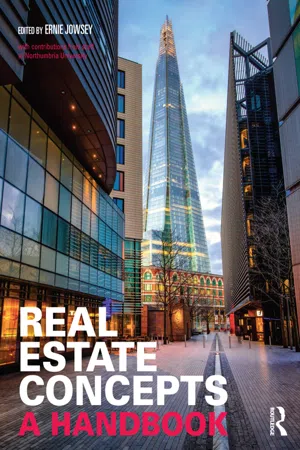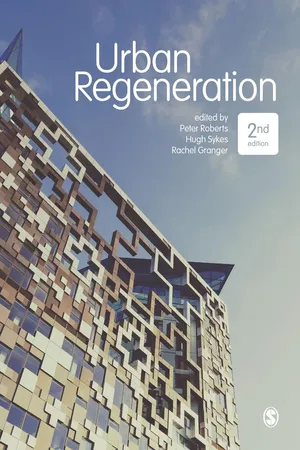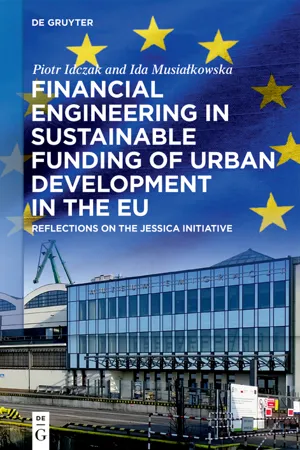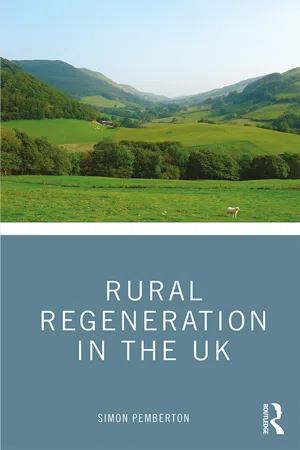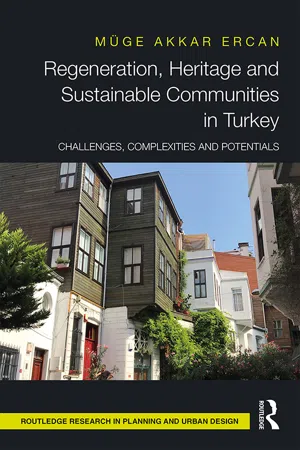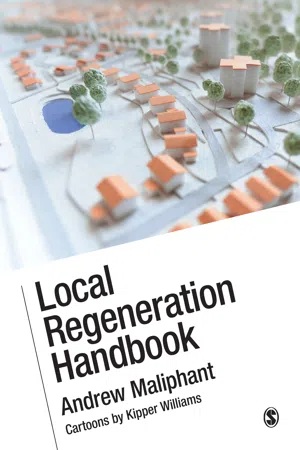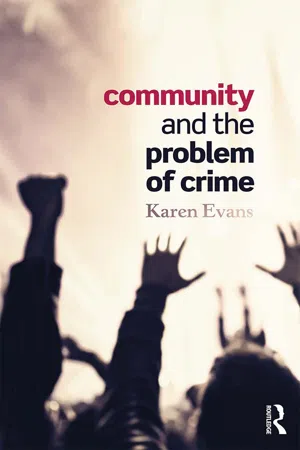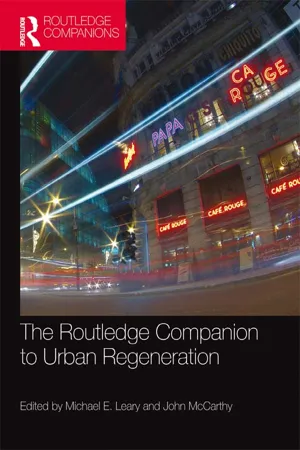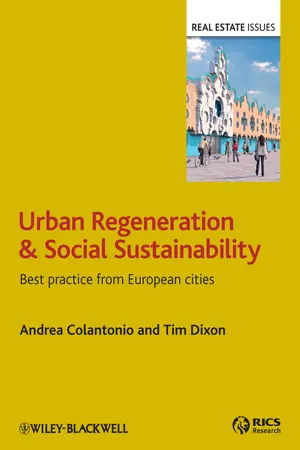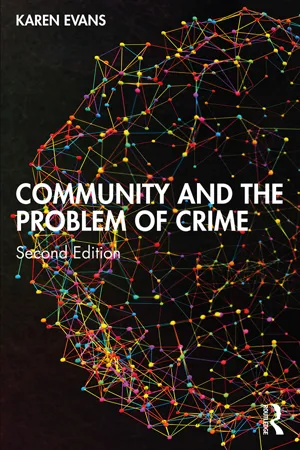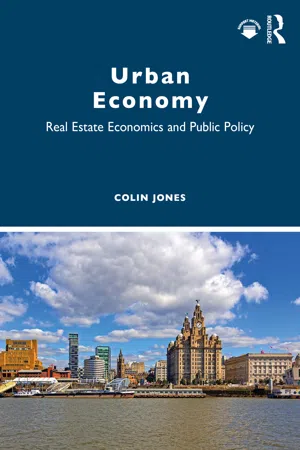Geography
Regeneration
Regeneration refers to the process of revitalizing and improving urban areas, often through physical, economic, and social interventions. It aims to address issues such as urban decay, social deprivation, and economic decline by redeveloping infrastructure, creating new amenities, and fostering community engagement. Regeneration projects seek to enhance the overall quality of life and opportunities within a specific area.
Written by Perlego with AI-assistance
Related key terms
Related key terms
1 of 4
Related key terms
1 of 3
12 Key excerpts on "Regeneration"
- eBook - ePub
Real Estate Concepts
A Handbook
- Ernie Jowsey, Ernie Jowsey(Authors)
- 2014(Publication Date)
- Routledge(Publisher)
14 Regeneration Julie Clarke, Hannah Furness, Paul Greenhalgh, Rachel Kirk and David McGuinness 14.1 Defining urban RegenerationKey terms: urban Regeneration; neighbourhood renewal; area-based initiatives; multiple deprivationRegeneration is a term that is widely misused and misunderstood. It means different things to different people, and can range from large-scale activities that promote economic growth, to neighbourhood interventions that improve people’s quality of life. Fundamentally, it is a holistic process of reversing economic, social and physical decline in areas where market forces alone will not suffice. Holistic Regeneration may be conceptualised as a stool, the three legs of which represent physical, economic and social aspects, without any one of which the stool will fall over.Urban Regeneration as an idea encapsulates both the perception of a town or city in decline and the hope of renewal, reversing trends in order to find a new basis for economic growth and social well-being. It may be defined as a comprehensive and integrated vision and action that leads to the resolution of urban problems and that seeks to bring about a lasting improvement in the economic, physical, social and environmental condition of an area that has been subject to change (Roberts and Sykes, 2000).Physical Regeneration is work on the physical fabric of an area where such work forms part of a strategy to promote social, physical and economic improvements in a given locality, rather than just redevelopment driven solely by market forces (Commission for Racial Equality, 2007). It is necessary to clearly distinguish physical Regeneration activity from redevelopment; the latter has arguably been occurring ever since urban settlements existed. It is the process of recycling or reusing land that has already been developed, and may involve demolition, land remediation and reclamation, rebuilding, rehabilitation, conversion and change of use etc. To be considered to be physical Regeneration, a project must have some public sector input or intervention that results in it making a contribution beyond the delivery of profitable or worthwhile property development. - eBook - ePub
- Peter Roberts, Hugh Sykes, Rachel Granger, Peter Roberts, Hugh Sykes, Rachel Granger(Authors)
- 2016(Publication Date)
- SAGE Publications Ltd(Publisher)
Having identified and traced the evolution of some of the major issues and factors that have been evident in previous eras of urban change and policy, the preceding section of this chapter isolated six important themes which represent the origins and outcomes of past problems and policy responses. Although they reflect the enduring and continuous nature of economic, social and physical change, they do not yield, by themselves, the basis for a comprehensive definition of urban Regeneration. In order to help to construct a working definition of urban Regeneration it is also necessary to identify emerging areas of concern and likely future challenges. As was argued above, the most important of these challenges is that which is represented by the need to ensure that all areas of public and private policy operate in accord with the economic, social, environmental and political principles embodied in the notion of sustainable development.A Definition of Urban Regeneration
Although the very nature of Regeneration makes it a constantly evolving and varied activity, the six themes provide the basis for an initial definition of urban Regeneration as:comprehensive and integrated vision and action which seeks to resolve urban problems and bring about a lasting improvement in the economic, physical, social and environmental condition of an area that has been subject to change or offers opportunities for improvement.This somewhat ideal definition encompasses the essential features of urban Regeneration identified by Lichfield, who points to the need for ‘a better understanding of the processes of decline’ and an ‘agreement on what one is trying to achieve and how’ (Lichfield, 1992: 19); by Hausner, who emphasises the inherent weaknesses of approaches to Regeneration that are ‘short-term, fragmented, ad hoc and project-based without an overall strategic framework for city-wide development’ (Hausner, 1993: 526); by Donnison in his call for ‘new ways of tackling our problems which focus in a co-ordinated way on problems and on the areas where those problems are concentrated’ (Donnison, 1993: 18); and by Diamond and Liddle (2005) who emphasise the need for action across all relevant policy spheres.The definition given above represents urban Regeneration designed and delivered in a total package and to the final point of completion. However, as Tallon (2010) observes, the reality is that Regeneration often operates in a fragmented manner and not all problems are solved. - eBook - ePub
Financial Engineering in Sustainable Funding of Urban Development in the EU
Reflections on the JESSICA Initiative
- Piotr Idczak, Ida Musiałkowska(Authors)
- 2022(Publication Date)
- De Gruyter(Publisher)
de Magalhães, 2015 ). Regeneration interventions realise the need to counter localised market failures and to achieve an equity objective (regarded as social cohesion). These actions lead to attaining additional social, economic and environmental outputs and outcomes which would otherwise not have occurred or which would have been yielded at an unsatisfactory level.Of particular importance in this context is a holistic approach. This stipulates that any Regeneration initiatives should be implemented by bringing a wide range of social, economic and environmental considerations into the decision-making process on an integrated programme of urban development. The idea considers the Regeneration programme as relating to a complete city system, and rejects a piecemeal approach. To address the issues resulting from this comprehensiveness, the needs and aspirations of local residents to redevelop their locality are supposed to be met in the wake of the coordination of a number of private and public sector actions (Couch, Sykes, & Börstinghaus, 2011 ). Moreover, the formulation of solutions to the problems of deprived urban area residents and people living in the neighbourhood should take place by way of a common vision, agreed objectives and priorities, pooled expertise and common decisions for the allocation of resources. In this respect it should also be underlined that, following de Magalhães’s view (2015) , the core understanding of what socio-economic decline in cities means must be seen as social, economic and environmental problems of a city (locality) rather than as social, economic and environmental problems that happened to take place in that locality. Therefore urban Regeneration through holistic approach policies seeks to address the problems of cities in all their multiple dimensions. It is then characterised by agendas of inclusiveness, multi-agency partnerships, and a shift from government to governance (J. Evans & Jones, 2008 - eBook - ePub
- Simon Pemberton(Author)
- 2019(Publication Date)
- Routledge(Publisher)
First, he notes how ‘Regeneration’ in Latin means ‘rebirth’ and associated Judeo-Christian concerns with ‘being born again’ (Furbey, 1999). Indeed, for Jones and Evans (2008), they note how such a notion was very appealing during the 1980s when urban policy under Prime Minister Margaret Thatcher was informed by a neo-liberal, market-based approach focused on individuals rather than communities. In turn, they argue that “Regeneration – as opposed to mere ‘redevelopment’ – became a moral crusade, rescuing not only the economy but the soul of the nation” (Jones and Evans 2008, p.2). This distinction between Regeneration and redevelopment is crucial in the context of rural areas. While considerable attention has focused on rural and regional development – albeit with each often having different objectives and operating at different scales (see Woods, 2005) – there has been much less focus on rural Regeneration per se. However, finding an explicit definition of how rural Regeneration may differ from rural development is problematic. Of the studies – both academic and policy-related – that consider rural Regeneration, hardly any offer a definition. For example, Osborne, Williamson and Beattie (2004) attempt to delineate how rural Regeneration may be different from urban Regeneration (see below). But in terms of a definition, they offer only a broader conception of Regeneration “denoting programmes and policies intent to lead to the social, economic and/or community development or rejuvenation of a local area – and particularly where this area has recently suffered significant decline or depopulation” (Osborne et al., 2004, p.158). The most useful distinction between rural development and rural Regeneration is made by Woods (2005). He notes how “development suggests a process of progressive change or modernisation … thus the provision of electricity to rural parts of the United States, for example, was clearly a rural development project” (Woods, 2005, p.146) - eBook - ePub
Regeneration, Heritage and Sustainable Communities in Turkey
Challenges, Complexities and Potentials
- Muge Akkar Ercan(Author)
- 2019(Publication Date)
- Routledge(Publisher)
raison d’être for conservation in all senses’ (Avrami and Mason, 2000: 4). Hence, protecting poor, vulnerable communities living and working in deprived historic urban quarters in accordance with their multifaceted needs, aspirations and values, and ultimately turning them into SCs is also indispensable for sustainable urban conservation. Therefore, particularly in historic neighbourhoods, the difficult task of conservation initiatives is to develop strategies not only ensuring the continuing contribution of heritage to the present and the future through the thoughtful and intelligent management of change responsive to the heritage environment and collective needs, but also preserving the fundamental elements of the social environment. If such strategies find ways of reconciling the needs, aspirations and concerns of local communities and the conservation of the heritage geographies with multiple values, they are likely to develop more equitable and sustainable solutions to the problems of historic quarters.The effectiveness and success of (sustainable ) Regeneration endeavours in heritage geographies, therefore, depend on three main conditions: first, the extent to which they protect vulnerable, poor communities by meeting their economic, social, cultural, environmental, health and political needs, ultimately turning them into SCs; second, the extent to which they restore heritage geographies by adopting present needs without risking the loss of inherited built resources with their interrelated sets of values for future generations; and finally, the extent to which they achieve both objectives in a sustainable and balanced fashion. The understanding of community needs is elaborated further in the next sections.Relational understanding of Regeneration spaces in cities
In an era of globalisation and neoliberal urbanism, Harvey (2016: 137) defines urbanisation as ‘a spatially grounded social process in which a wide range of actors with quite different objectives and agendas interact through a particular configuration of interlocking spatial practices’. It produces numerous artefacts, such as constructed spaces and resource systems, as well as institutional arrangements, legal forms, political and administrative systems and hierarchies of power (Harvey, 2016). Indeed, spaces are ‘interrelated entities’ that are open to and engaged with other spaces and places. They are ‘relational constructs’ made by biological, physical, economic, social and cultural processes and relations established between entities of various kinds (Murdoch, 2006). According to Harvey (1996), discrete spaces and places need to be regarded as dynamic configurations of ‘relative permanences’. The resonances of the relational approach to urban Regeneration are therefore twofold: first, to conceptualise Regeneration spaces as the notions of ‘relative permanence’ and ‘perpetual perishing’ in a time–space relation; and second, to conceive them with reference to the spatio-temporal dynamics; i.e. spatial changes in time. By conceiving Regeneration spaces as ‘semi-permanent’ with a spatio-temporal perspective rather than ‘static’ and ‘contained’ in time moving in one directional and linear way, it is possible to discover the ‘flow’ and ‘fixity’ nature of spaces. - eBook - ePub
- Andrew Maliphant(Author)
- 2017(Publication Date)
- SAGE Publications Ltd(Publisher)
5 Sustainable Development I: Social Regeneration Working with Your Local Community From what we’ve said so far, I might have put this as the first chapter. This is the first of three chapters looking in more detail at the three-legged stool of sustainable development.Community
What does ‘community’ mean to you?- Fluffy – unfocused – wish list – impractical – and basically somebody else’s worry (a trickle-down Regeneration or bricks-and-mortar Regeneration view)
- Anything not covered by economic development, land use planning or climate change (an academic view)
- Community is the only real issue, ignored by the really hard-to-reach groups – local government officers, outside experts and developers (a neighbourhood activist view)
The fact is, Regeneration is a change process for the benefit of local people (including local businesses – ‘the business community’), and if you’re not doing it for the community, then you’re doing it wrong. It’s also enlightened self-interest to involve the community in Regeneration, as they hold the key to resources not available to anyone else, know more about their local area, and the end result will be more long-lasting or ‘sustainable’ as a result.‘Community’ of course is a broad term, and includes ‘communities of place’ (residents of a local area, who may not have much in common with each other) and ‘communities of interest’ (people who have things in common like sport and other cultural activities but don’t necessarily live in the same street). Involving the community takes time, not least due to this diversity, but the different ways of doing so are well known (see Community Involvement later in the chapter), and more are being developed, such as through the ‘Transition’ movement. See also the lexicon of ‘community’ terms in Appendix 3, there’s yards of them!Anything without a community focus that looks like Regeneration is more likely to be development, i.e. for private or corporate benefit. Development does of course bring some community benefits – some jobs for local people and more customers for local businesses, some physical improvements to derelict areas, and a general rise in local morale – and you will find significant people who think this is enough. However, the ‘trickle-down’ effect from development needs extra help through regulation and training to benefit local people, it doesn’t happen on its own – particularly in so-called ‘deprived’ areas where morale is low – and doesn’t happen at all if the jobs and trade (and houses) all go to outsiders. - eBook - ePub
Fitting into Place?
Class and Gender Geographies and Temporalities
- Yvette Taylor(Author)
- 2016(Publication Date)
- Routledge(Publisher)
The (mis)management of resources and uneven effects suggests again the vulnerabilities of particular people and places within the logics of Regeneration/degeneration. Spatial segregations are renewed rather than seamlessly transformed, where, for example, rural Regenerations mean something quite different from urban Regeneration – in the case of ex-mining communities this included being ranked as ‘deprived’ and being in receipt of European Social Funds to simply ‘get by’ rather than to get ahead culturally or economically. Regeneration as a policy itself produces spatialised orientations of and for accumulative, ‘active’ citizens as opposed to more ‘pragmatic’ citizens, with the latter often being absented from ideas of ‘city publics’ (Watson 2006, Back 2007): such orientations, as dispositions and feelings, are disproportionately aligned and/or at odds with regional change. Even well-resourced residential and leisure areas were at times positioned as going too far, as material improvements was repositioned as a loss by and for middle-class subjects who could articulate a claim as losing out, being ‘crowded out’ by the wrong kind of ‘influx’; often this middle-class claim was expressed an aesthetic degeneration of their landscapes. This chapter explores the moral and material positions of ‘improvement’ and the proximities and distances that are invoked through, for, and by ‘improving’ people/ places. Distance invokes both time and place and certain geographical locations were viewed as moving too fast, colliding past and present terrain, in becoming something different: such changes were variously perceived as assets or failures in ‘crowding out’ the once protected, authentic, middle-class terrain - eBook - ePub
- Karen Evans(Author)
- 2015(Publication Date)
- Routledge(Publisher)
In the 1970s, the social contract was still more or less intact. The postwar rebuilding of cities was largely achieved with funding from national governments, and urban renewal was largely considered a national and public matter. So the crisis of deindustrialisation, rising unemployment and increasing poverty was initially considered the responsibility of the state to attempt to resolve. Subsequently, however, responsibility began to shift away from the national state, the problem was pushed further down to local and regional state authorities and then, beginning in the 1980s it was expected that partnerships would be built with the private sector to lever in finance from this sector too. As the financing models have changed, so too has the focus of the partners involved. Postwar urban renewal emphasised the development of society and the provision of infrastructure and housing. It reflected a certain optimism that building the physical infrastructure for future economic and social success would benefit the country as a whole and lead to a general growth in prosperity. By the 1970s, however, this optimism had faded, and the idea of Regeneration of failed local economies, rather than renewal of neighbourhoods and society, gained currency. The Regeneration discourse is more concerned with responding to and finding ways to adapt to a crisis, whether this is manifest at the level of the economy or community and neighbourhood. Perversely, given that the problem of deindustrialisation and economic degeneration was global in its reach, Regeneration has been largely driven at a local level. As we will see later in this chapter, this was in part a move away from the imposition of national solutions onto local communities and a concern to devolve responsibility to the local level (Roberts and Sykes 1999). Regeneration policies also had the effect of fragmenting responses to problems which were manifest nationally and internationally. To be successful, Regeneration should include an analysis of factors which are economic, social and related to the built environment which are considered to be holding back a particular local area. It should also formulate a strategy which can address all of these factors. The next section looks at the economic policies considered necessary to Regeneration in different periods.Regenerating economy
The first Regeneration strategies were designed to allow adaptations in the industrial environment in which towns and cities operated. Deindustrialisation had left whole areas of cities without an economic function as industries withdrew but left behind buildings and machinery which were now redundant. The devastation left by the retreat of industry was palpable and physical as well as social in its impact. Local councils, aided initially by access to central government funds, encouraged town planning authorities to allow a redesignation and refunctioning of these abandoned spaces to allow emerging industries (often based in the service rather than the production sectors) to sweep away the old and replace with new office and factory spaces more appropriate for their needs. This phase also involved retraining local workers so that they would learn new skill-sets considered more relevant to production needs in the late twentieth century. Schools and colleges were also expected to get involved, adapting curricula to educate young people for the demands of emerging technology and knowledge-based industries. The new industries, however, did not require the large workforces necessary to establish and sustain manufacturing. This led to fears that large sections of urban populations might remain largely economically inactive and that authorities might have to plan for a ‘work society that is running out of work’ (Dahrendorf 1985:119 in Crowther 2000:182). - eBook - ePub
- Michael E. Leary, John McCarthy, Michael E. Leary, John McCarthy(Authors)
- 2013(Publication Date)
- Routledge(Publisher)
It has been obvious for many years that a variety of problems confront communities and governments and that there is some variation between the difficulties faced in cities in the Global North compared with the Global South. These variations percolate through this Part (as they do in other Parts of the book) but what is also striking is how in recent years we have witnessed a growing convergence regarding some Regeneration responses. The notion of convergence is one that provides a conceptual peg for elements of the discussion in the substantive chapters that follow. Since it emerged as a discrete factor in national, regional and city-wide urban policy, Regeneration has sought to find long-term solutions to seemingly intractable problems. Precisely what constitutes an urban problem deserving of specialized public sector resources is, of course, highly politicized since it can bring with it not just additional resources but societal stigmatization. It is often a locally sensitive issue. Noticeably, the identification of urban problems has undoubtedly become more scientific through the use of statistical data, especially in the Global North where reliable data are usually more readily available.That said, the North/South dichotomy has limited utility as an analytical tool due to the extent of variation in the complexity of urban form, socio-economic issues and Regeneration approaches between and within the Global South and North. In Britain for example, demolition and comprehensive redevelopment of public housing areas deemed socially irredeemable continues in the 2000s, for instance in Manchester (Mace et al. 2007) where the results are generally seen as relatively successful (Grant 2010 ), and in South London (Montgomery 2011 ) where a hugely ambitious project requiring large-scale demolition of public housing has been dogged by controversy, governance and financial problems for ten years (Bar-Hillel 2013 ). Demolition also remains a feature of urban Regeneration in US in cities such as Chicago, Baltimore and Detroit but exceptionally, New York’s powerful City Housing Authority resisted pressures to demolish large areas of problematic public housing until recently (Fernandez 2010 ; Vitullo-Martin 2012 ). The London 2012 Olympic Park, one of Europe’s largest Regeneration projects, required the complete clearance of many homes and businesses in an area of East London that was considered semi-derelict and expendable (Raco and Tunney 2010 ). However, several authors argue that the extent to which such areas are beyond socio-economic repair and rehabilitation is a political as well as technical matter and is often contested, as it has been for decades. Part 1 illustrates how facets of globalized neo-liberalism have in the last two decades spread to take hold in many countries around the globe. And it would be folly to pretend the consequences of and concerns about these twin structural forces can or should be compressed only into the first Part of this book. It should therefore be no surprise to see these themes as well as those of convergence and divergence popping up in the chapters in this Part and in successive Parts. Convergence is often predicated on international urban policy transfer (Zhang and Fang 2004 ;Breda-Vázquez et al - eBook - ePub
Urban Regeneration and Social Sustainability
Best Practice from European Cities
- Andrea Colantonio, Tim Dixon(Authors)
- 2011(Publication Date)
- Wiley-Blackwell(Publisher)
These issues not only comprised dereliction, overheated housing markets ins some parts and failing demand in other regions and poor infrastructure, but to also the necessity of increasing the competitiveness, particularly of Eastern ‘ Bundesländer ’, and of improving education levels in disadvantaged urban areas as well as ensuring an equal quality of life in the whole of Germany. Therefore a range of new formal planning instruments and funding programmes was developed. These included ‘ Stadtumbaugebiete ’ (Urban Regeneration Areas), which were introduced in the scope of the 2004 planning reforms. Regeneration areas can be designated either as complementary to redevelopment areas or instead of them, and address a wider set of issues, which include failing property markets. In this context legal provision is made to subsidise the demolition of substandard and/or vacant properties (Battis et al., 2007). It is important to note in this context that a strategic approach to demolition is adopted, which can entail the demolition of properties on the urban fringe in order to preserve and regenerate inner city quarters with buildings of historic or heritage value. A key difference to redevelopment areas is therefore noticeable in that less rigorous tests are applied when checking whether the designation is justified. This is understandable as Regeneration areas are less powerful and usually less obtrusive planning instruments – giving planning authorities less control but at the same time more flexibility. The latter also relates to the indicators that signify that the presuppositions for designating a Regeneration area are present. After all, the purpose of Regeneration areas is to create long-term sustainability, which in turn implies that designated areas do not necessarily suffer from physical dereliction or the other statutorily defined structural deficits - eBook - ePub
- Karen Evans(Author)
- 2023(Publication Date)
- Routledge(Publisher)
Subsequently, however, economic and social problems were pushed further down to local and regional state authorities and then, from the 1980s, it was expected that partnerships would be built with the private sector to lever in non-government finance. As financing models have changed, so too has the focus of those involved. Post-war urban renewal emphasized the development of social value and the provision of infrastructure and housing reflecting an optimism that building the physical architecture for future economic and social success would benefit the country as a whole and lead to a general growth in prosperity. From the 1970s, however, this optimism has faded. Talk of urban renewal was replaced by the idea that many local economies had failed and the discourse of Regeneration gained currency. This Regeneration discourse was more concerned with responding to, and finding ways to adapt to, ongoing crisis at the level of the economy, neighbourhood or community. Whilst the problem of de-industrialization and degeneration of the economy was global in its reach, Regeneration has been largely driven at a local level. As we will see later on in this chapter, this was in part a move to devolve responsibility away from national governments and to responsibilize the local (Roberts and Sykes 1999) but Regeneration policies also had the effect of fragmenting responses to problems which were manifest nationally and internationally. Regenerating economy The first Regeneration strategies were designed to create adaptations in the physical and work environment in which towns and cities operated. De-industrialization had left whole areas of cities without an economic function as industries withdrew but left behind buildings, machinery and a workforce which were now redundant - eBook - ePub
Urban Economy
Real Estate Economics and Public Policy
- Colin Jones(Author)
- 2021(Publication Date)
- Routledge(Publisher)
The nature of the central urban decline was epitomised physically by large tracts of land lying unused, and derelict docks, industrial units or warehouses, vacated by closures. Very often, this former industrial land and docks were contaminated by the historic industrial processes once applied on their sites.The urban Regeneration challenge to address this legacy is, therefore, multifaceted. The overall impact is the result of a range of linked processes. It is not simply about rebuilding the physical fabric of the city. There is a spatial concentration of poverty. The inner-city urban economy needs to be reformulated with new land uses that generate incomes for the local residents. Better housing needs to be provided by improving the stock or replacing it.It is a social, physical and economic urban renewal planning challenge. Left to market forces, the task is unlikely to make much headway. In a sense the inner-city localities are suffering functional obsolescence as the previous land uses are no longer viable. There needs to be mechanisms to promote land use succession and create a new revitalised inner-city core or donut.The problem is that the economics of redevelopment is constrained by the scale of the dereliction and negative spillovers or externalities. It means widespread low or minimal land and property values. Any contamination needs to be treated, and derelict buildings be replaced before new development can occur. Although land values are low, the capital expenditure required to redevelop an individual site/building is prohibitive. The result is that without public financial support, land use succession is invariably unviable, at least in the initial phase of Regeneration.Traditional approaches to urban renewal
The long-established approach of urban Regeneration was to focus on the physical problems of cities. It was a response to the high densities and poor sanitary conditions of urban housing built after the industrial revolution. Policies took the form of replacing the slums by new modern housing through public programmes. Slum clearance in UK cities began in the mid-1800s on a low scale by individual local authorities under public health laws, without rebuilding. The first national slum clearance programme in the UK began in 1933 with replacement public housing and was interrupted by World War II. With national housing shortages, it was not until the late 1950s it began again in earnest.
Index pages curate the most relevant extracts from our library of academic textbooks. They’ve been created using an in-house natural language model (NLM), each adding context and meaning to key research topics.
Explore more topic indexes
Explore more topic indexes
1 of 6
Explore more topic indexes
1 of 4
